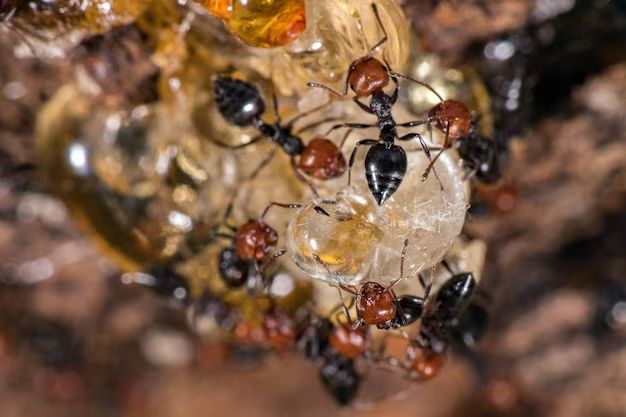Ants are incredibly diverse insects that come in a wide variety of colors, sizes and behaviors. There are over 12,000 known ant species around the world, each adapted to live in different environments. When it comes to identifying a specific type of ant, details like the coloration of their head, thorax and abdomen can be very useful clues. If you’ve noticed an ant with a red head and black body, this narrows it down to a couple likely suspects.
Page Contents
Fire Ants
One of the most notorious ants with a reddish head and dark abdomen is the fire ant. There are several different fire ant species, with some of the most common being the red imported fire ant (Solenopsis invicta) and the black imported fire ant (Solenopsis richteri).
Fire ants are native to South America but have spread via international commerce to become invasive pests in places like the United States, Australia and China. They get their name from their painful stings, which cause a sensation similar to being burned by fire. Fire ants use their stings to defend their nests, which can house up to several hundred thousand worker ants led by a queen.
Worker fire ants range from 1/16 to 1/4 inches (1.5 to 6 mm) in length. Their bodies are a darker brownish-black color, while their heads tend to be a reddish-orange. The darker abdomen helps them heat up more quickly when in the sun. Fire ants also have a 10-segmented antennae with a two-segmented club at the end.
When foraging, fire ants will travel up to 100 yards (91 m) from their nest in search of food. They feed on small animals, plants, seeds and honeydew from aphids or other sap-sucking insects. Fire ants are aggressive defenders of their nest and will quickly swarm over any intruders they perceive as threats. Their stings can cause swelling, blisters and itching that lasts up to a week.
Carpenter Ants
Carpenter ants get their name because they build their nests by excavating wood. Like fire ants, carpenter ants have darker abdomens and reddish-colored heads. There are over 1,000 species of carpenter ants, with the most common types in North America being the black carpenter ant (Camponotus pennsylvanicus) and the western carpenter ant (Camponotus modoc).
Carpenter ants nest in hollowed out galleries within wood, including logs, stumps, trees and timber in structures. The ants don’t actually eat wood, but excavate it to create their nest galleries. Carpenter ants don’t have a painful sting, but can inflict a mild bite while defending their nest.
Worker carpenter ants range from 1/4 to 1/2 inch (5 to 13 mm) in length. Their abdomens are mostly black, sometimes with a slight bluish or reddish tint. The thorax is also mostly black. Their heads are a reddish-orange color. The antennae are elbowed and have 12 segments, with a three-segmented club at the end.
Carpenter ants forage at night for sources of protein and sugar. During the day, they remain inside their wood galleries. At night, they emerge and search for food up to 100 feet (30 m) away from the nest. Carpenter ants feed on living or dead insects, plant nectar, honeydew and leftover human foods.
How to Tell the Difference
While fire ants and carpenter ants can look similar, there are some key differences that can help identify them:
| Fire Ants | Carpenter Ants |
|---|---|
| Multiple queens per nest | Single queen per colony |
| Nests in soil mounds | Nests in wood galleries |
| 1/16 to 1/4 inch long | 1/4 to 1/2 inch long |
| Painful sting | Mild bite, no sting |
| Forage during day | Forage at night |
Some key points in differentiating between fire ants and carpenter ants:
- Fire ants build nest mounds out of soil with multiple queens, while carpenter ants excavate galleries within wood and have a single queen.
- Carpenter ants are larger on average than fire ants.
- Fire ants have a painful sting as defense, while carpenter ants can only bite.
- Fire ants actively forage during the day, while carpenter ants avoid the light and forage at night.
Avoiding Ant Bites and Stings
Ants like fire ants and carpenter ants can become nuisance pests when they invade areas near humans. Their stings and bites can be annoying, so it’s best to take precautions to limit contact:
- Wear closed toe shoes and long pants when outside near ant nests.
- Clean up any food spills or crumbs that could attract foraging ants.
- Seal cracks and openings in structures that ants could use to enter.
- Inspect wood before bringing it indoors for signs of carpenter ant galleries.
- Treat ant nests with insecticidal baits or dusts designed for the target species.
- Consider contacting a pest control professional for severe infestations.
Taking these steps to keep ants away from living spaces and being cautious outdoors can help avoid unpleasant bites or stings.
Conclusion
If you spot an ant with a reddish head and dark abdomen it is likely either a fire ant or a carpenter ant. Fire ants build soil nests with multiple queens and aggressively sting intruders. Carpenter ants excavate galleries in wood, have a single queen and can only deliver a mild bite. both types of ants can become nuisance pests. Avoiding contact and taking measures to exclude them from structures and yards can help prevent unwanted ant encounters.
